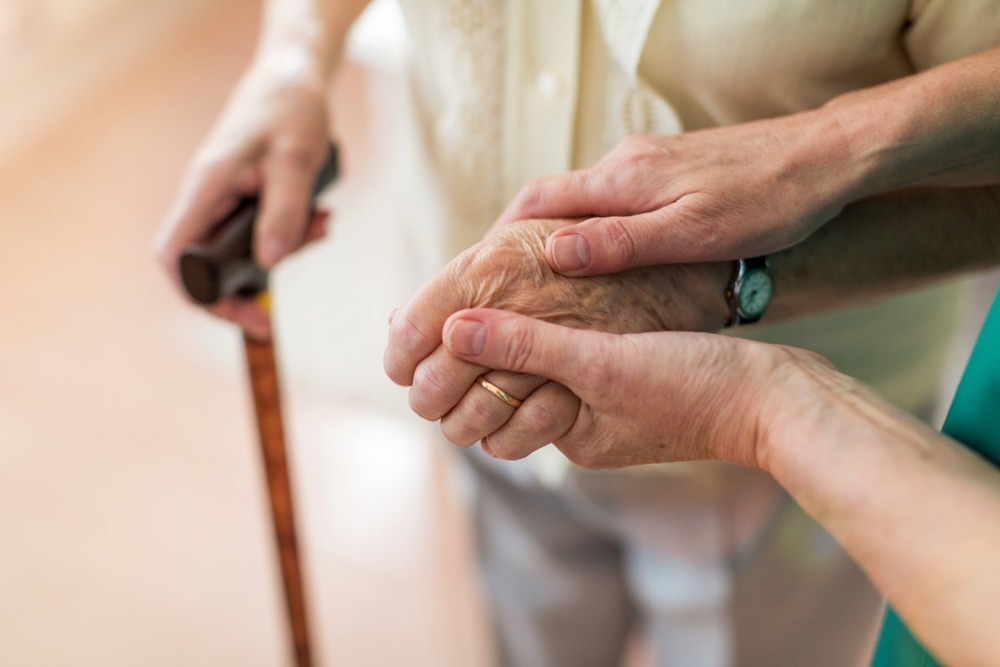The demographic shift: Aging populations worldwide
Promoting independence in senior living
Technological innovations in care for older people
The role of AI and robotics in geriatric care
Policy and infrastructure for aging societies
Ethical considerations in aging care innovations
Future directions in senior care innovations
Conclusion
References
Further reading
Aging populations can be noted in many populations across the globe.1 This happens when the median age within a society increases as the fertility rate falls, with older individuals outnumbering their younger counterparts.1
As a population changes, its needs can also change. Much gerontological research aims to support these needs through preventative interventions and technological innovation. 2,3

Image Credit: GoodStudio/Shutterstock.com
The demographic shift: Aging populations worldwide
International population projections indicate that the number of individuals aged 80 and above is expected to increase by more than threefold by the year 2050, rising from 126.5 million to over 446.6 million. 1
The World Health Organization considers those who are over 80 to be the "oldest old": a group that may require particular support in aging healthily and living independently. 2,4 Multimorbidities are commonplace among this age group, and this can pose challenges to healthcare organizations.5 For example, hospital admissions and readmissions, along with the length of stay, increase with multimorbidities. 5
Promoting independence in senior living
Both social and technological innovation can be used to support people in living independently. 6,7 This can happen on an individual level, as well as within wider social healthcare settings. 6
The Senior Living Lab is a research hub based in Switzerland with a focus on innovation and aging at home.7 Their multidisciplinary research identified three areas that would benefit from innovation to support older individuals living at home:
- Autonomous and independent mobility;
- Targeted nutrition;
- Communication and community to decrease isolation.
The group argues that adequate support for older people should be provided. Ecological changes should be made to the environment, as opposed to only individual behavioral changes.7
Geriatric Pharmacology: Medication Management for an Aging Population
Technological innovations in care for older people
Technological innovation can include both designing or developing new tools and adapting pre-existing technology to fit an individual's access needs better.8
The range of tools that can be used to support senior health can vary greatly, from those that are designed with this particular population in mind to others that are marketed to a broader audience. For example, Smart Home Technologies such as Voice-Activated Devices and virtual assistants can both offer support to those who are experiencing social isolation.9
Some research suggests that older adults may be interested and willing to use technology in their homes that can help provide support, particularly if it is well-integrated into their environment.10 Smart Home Technologies could be a powerful tool for this reason.
The role of AI and robotics in geriatric care
Robotics could be a particularly useful assistive tool for geriatric psychiatry.11 A literature review undertaken in 2021 noted that assistive robots can offer particular benefits for providing care in the face of widespread communicable diseases, such as COVID-19, in a safe way.11 Autonomous social robots, which can provide companionship, mental stimulation, and cognitive enrichment, seem to offer particular value to geriatric psychiatric care.12
Some researchers note that care robots can be limited in scope. Specifically, the nuance of care and the ability to holistically consider a patient's case is limited, as robotic design can only be personalized so much.13
Research into the use of Artificial Intelligence in geriatric healthcare is growing, but there are still significant gaps in the research.14 Because of this, its exact role in supporting an aging population is unclear. However, it seems that it may be a helpful tool for supporting dementia patients, a syndrome that is more commonly diagnosed among older adults.15 For instance, deep learning networks have shown promise in identifying biomarkers of Alzheimer's disease.15
Robots Working In Elder Care | TIME
Policy and infrastructure for aging societies
A comparative analysis was undertaken across select countries in Scandinavia, North America, and The United Kingdom to investigate the use and uptake of innovative technology in health and social care settings.6 The findings suggest that although technology is emerging rapidly, relevant policies aren't changing at the same pace.6

Image Credit: pikselstock/Shutterstock.com
Public policy can lead to difficulties in ensuring that innovations are available in an accessible and widespread way.16 Specifically, distributing technology on the systematic level - such as within healthcare or in social care settings - can be a challenging process.16
Digital strategies, like eHealth policies, can improve the care provided to an aging population.17 Denmark, Sweden, and Norway all integrate digitalization into healthcare for older adults.18 However, there are issues in these systems, with older patients becoming disengaged and therefore becoming excluded from these services.18 To fully unlock the potential of digital healthcare policies in an aging population, these systems must be accessible and effectively implemented.
Ethical considerations in aging care innovations
Preserving autonomy and dignity is crucial to the development of geriatric healthcare. 18,19 Considering the population's needs and concentrating on their experiences could be fundamental to ensuring these considerations are accounted for. 20
An ongoing debate in innovation is who the target audience of these tools is. Some argue that a user-centered approach should be taken to innovate in an ethical and socially responsible way. 21 This perspective integrates the user - in this case, the older population - into each stage of the design and development of these technologies, such as during the prototyping and testing stages. 10
Future directions in senior care innovations
The aging population suggests that the need for care will only grow - particularly if projections and trends are sustained. 12 Social and technological innovation could also continue to grow in the face of this, shaping health and social care to support such demographics more appropriately. 22
Some areas of technological innovation are relatively recent, especially concerning their use in aging populations. For instance, research into social robots shows promise but only started to gain notoriety during the 2000s and 2010s, so their full potential in supporting senior health outcomes may not be understood yet. 12
Another way that the care of older people may change is due to the increased prevalence of digital technology in modern life. 22 The digital divide, which underlines generational-based differences in the uses of technology, could potentially be mitigated with education, time, and increased access. 23,24 If this gap was lessened, it could pave the way for integrating technology into senior healthcare more fluidly.
Conclusion
A popular aim of gerontological research and innovation is to support individuals in living autonomously and independently as desired. Supporting older people in aging at home can help with this aim while also being frequently preferable to the individual.
Both technological and social innovation have contributed to the advancement of geriatric care, in addition to materially improving living conditions in an aging population. Despite this, access gaps still prevail, preventing some of those who may need support the most from accessing what is needed.
References
- He, W., Goodkind, D., & Kowal, P. R. (2016). An Aging World: 2015. https://www.census.gov/content/dam/Census/library/publications/2016/demo/p95-16-1.pdf
- Escourrou, E., Durrieu, F., Chicoulaa, B., Dupouy, J., Oustric, S., Andrieu, S., & Gardette, V. (2020). Cognitive, functional, physical, and nutritional status of the oldest old encountered in primary care: a systematic review. BMC Family Practice, 21(1), 1-10. https://www.ncbi.nlm.nih.gov/pmc/articles/PMC7099824/
- Gao, W., Chen, Y., Xu, S., Lyulyov, O., & Pimonenko, T. (2023). The Role of Population Aging in High-Quality Economic Development: Mediating Role of Technological Innovation. SAGE Open, 13(4), 21582440231202385. https://journals.sagepub.com/doi/full/10.1177/21582440231202385
- McMaughan, D. J., Oloruntoba, O., & Smith, M. L. (2020). Socioeconomic status and access to healthcare: interrelated drivers for healthy aging. Frontiers in public health, 8, 231. https://www.ncbi.nlm.nih.gov/pmc/articles/PMC7314918/
- Kingston, A., Robinson, L., Booth, H., Knapp, M., Jagger, C., & Modem Project. (2018). Projections of multi-morbidity in the older population in England to 2035: estimates from the Population Ageing and Care Simulation (PACSim) model. Age and ageing, 47(3), 374-380. https://pubmed.ncbi.nlm.nih.gov/29370339/
- Berridge, C., Furseth, P. I., Cuthbertson, R., & Demello, S. (2014). Technology-based innovation for independent living: policy and innovation in the United Kingdom, Scandinavia, and the United States. Journal of Aging & Social Policy, 26(3), 213-228. https://pubmed.ncbi.nlm.nih.gov/24716894/
- Angelini, L., Carrino, S., Abou Khaled, O., Riva-Mossman, S., & Mugellini, E. (2016). Senior living lab: An ecological approach to foster social innovation in an ageing society. Future Internet, 8(4), 50. https://www.mdpi.com/1999-5903/8/4/50
- Shute, V. J., & Zapata‐Rivera, D. (2007). Adaptive technologies. ETS Research Report Series, 2007(1), i-34. https://onlinelibrary.wiley.com/doi/abs/10.1002/j.2333-8504.2007.tb02047.x
- Corbett, C. F., Wright, P. J., Jones, K., & Parmer, M. (2021). Voice-activated virtual home assistant use and social isolation and loneliness among older adults: mini review. Frontiers in Public Health, 9, 742012. https://www.frontiersin.org/journals/public-health/articles/10.3389/fpubh.2021.742012/full
- Wilkowska, W., Brauner, P., & Ziefle, M. (2018). Rethinking technology development for older adults: A responsible research and innovation duty. Aging, Technology and Health (pp. 1-30). Academic Press. https://psycnet.apa.org/record/2018-00762-001
- Kulpa, E., Rahman, A. T., & Vahia, I. V. (2021). Approaches to assessing the impact of robotics in geriatric mental health care: a scoping review. International Review of Psychiatry, 33(4), 424-434. https://psycnet.apa.org/record/2021-11611-001
- Sekhon, H., Cray, H. V., & Vahia, I. V. (2022). Robots in Geriatric Mental Health: Pipe Dream or Viable Solution?. The American Journal of Geriatric Psychiatry, 30(2), 246-248. https://pubmed.ncbi.nlm.nih.gov/34593303/
- Maibaum, A., Bischof, A., Hergesell, J., & Lipp, B. (2022). A critique of robotics in health care. AI & Society, 1-11. https://link.springer.com/article/10.1007/s00146-021-01206-z
- Chowdhury, M., Cervantes, E. G., Chan, W. Y., & Seitz, D. P. (2021). Use of machine learning and artificial intelligence methods in geriatric mental health research involving electronic health record or administrative claims data: a systematic review. Frontiers in psychiatry, 12, 738466. https://www.frontiersin.org/journals/psychiatry/articles/10.3389/fpsyt.2021.738466/full
- Leyhe, T., Reynolds III, C. F., Melcher, T., Linnemann, C., Klöppel, S., Blennow, K., ... & Hampel, H. (2017). A common challenge in older adults: Classification, overlap, and therapy of depression and dementia. Alzheimer's & Dementia, 13(1), 59-71. https://pubmed.ncbi.nlm.nih.gov/27693188/
- Lee, J., Burkett, B. J., Min, H. K., Senjem, M. L., Lundt, E. S., Botha, H., ... & Jones, D. T. (2022). Deep learning-based brain age prediction in normal aging and dementia. Nature Aging, 2(5), 412-424. https://pubmed.ncbi.nlm.nih.gov/37118071/
- MacNeil, M. (2019). Policies and Regulations to Enable Innovation and Adoption of Health Technologies for Older Adults: Documented Problems and Proposed Solutions. https://uwspace.uwaterloo.ca/handle/10012/15340
- Robbins, T. D., Keung, S. N. L. C., & Arvanitis, T. N. (2018). E-health for active ageing; A systematic review. Maturitas, 114, 34-40. https://pubmed.ncbi.nlm.nih.gov/29907244/
- Rapp, T., Sicsic, J., Ronchetti, J., & Cicchetti, A. (2023). Preventing autonomy loss with multicomponent geriatric interventions: A resource-saving strategy? Evidence from the SPRINT-T study. SSM-Population Health, 24, 101507.
- Chun, S., & Nam, K. (2019). User-centred design approaches for planning inpatient room of geriatric long-term care hospitals: Design factors with practical suggestions. The Design Journal, 22(4), 413. https://pubmed.ncbi.nlm.nih.gov/29907244/
- Coleman, R., Clarkson, J., & Cassim, J. (2016). Design for inclusivity: A practical guide to accessible, innovative and user-centred design. crc Press. https://www.routledge.com/Design-for-Inclusivity-A-Practical-Guide-to-Accessible-Innovative-and-User-Centred-Design/Coleman-Clarkson-Cassim/p/book/9780566087073
- Jarke, J. (2021). Ageing Societies and Technological Innovation. Co-creating Digital Public Services for an Ageing Society: Evidence for User-centric Design, 5-13. https://library.oapen.org/handle/20.500.12657/42574
- Pásztor, J., & Bak, G. (2020). Digital divide: A technological generation gap. Management, Enterprise and Benchmarking in the 21st Century, 158-168. https://www.researchgate.net/publication/349007530_Digital_Divide_-_A_Technological_Generation_Gap
- de Carvalho, C. V., Cano, P., Roa, J. M., Wanka, A., & Kolland, F. (2019). Overcoming the Silver Generation Digital Gap. J. Univers. Comput. Sci., 25(12), 1625-1643. https://kris.kl.ac.at/en/publications/overcoming-the-silver-generation-digital-gap
Further Reading
Last Updated: Jul 29, 2024